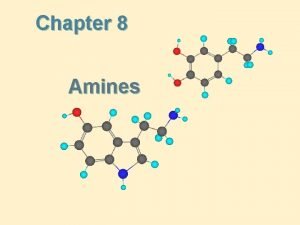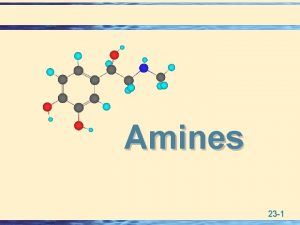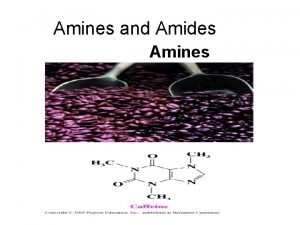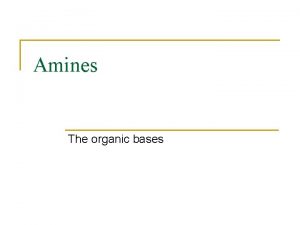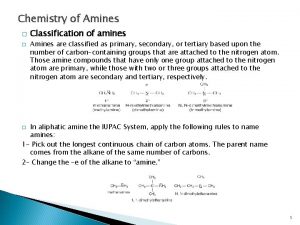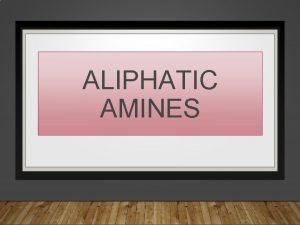lecture 4 Amines are extremely important functional groups





- Slides: 5

lecture 4 ﻋﻀﻮﻳﺔ Amines are extremely important functional groups in medicinal chemistry and are present in many drugs. Amines are present in amino acids of proteins, purine and pyridines of DNA and porphyrine ring of hemoglobin of the blood. Types of Amines: The nitrogen atom has one lone pair of electrons and can act as a hydrogen bond acceptor for one hydrogen bond. Primary amines consist of one carbon atom attach to NH 2 group, secondary amines have N–H groups, so both of them can act as hydrogen bond donors. Figure 1: - Hydrogen bonding interaction HBA : hydrogen binding acceptor. HBD: hydrogen binding donor. The tertiary amines haven't N–H group (water insoluble), while the Quaternary amines its similar to the tertiary amines but with positive charge on the nitrogen atom as shown in figure (2). Fig. 2:

Solubility: In many cases, the amines can form Hydrogen bonds with water Amines with 6 carbon atoms are water soluble due to this Hydrogen bonding. Water solubility decrease as the length of Hydrocarbon portion of the molecule increase. Alternatively, a strong ionic interaction may take place with a carboxylate ion in the binding site(Fig. 3). Fig. 3: Hydrogen bonding of Amines. Amine levels in different foods Fish, cheese, some meats, some fruit such as bananas and avocados, some vegetables such as mushrooms, and fermented foods such as chocolate are just some of the foods that have been listed as containing varying levels of amines, but basically any protein food can contain amines depending on the way it is handled. The amine content of foods varies greatly due to differences in processing, age, handling, storage and many other factors. The new method of meat distribution in our supermarkets is a problem for amine responders. All meat is now vacuum packed, repacked and sold as fresh which means it can be up to ten weeks old when you eat it. Studies show that vacuum packing can inhibit the growth of bacteria but does nothing to retard the development of amines

The content of amines in foods: Amines are present in many forms in human body (Proteins, DNA & others), also in plants (food). Amines are an unavoidable food, that can’t be removed from food. Simply, you can’t buy amine free food. All foods are made up of hundreds of naturally occurring compounds that can have varying effects on us, depending on how much we eat and how sensitive we are (Table -1). Table -1: Different contents of Amines in foods. Biogenic amines (BAs): - Biogenic amines (BAs) are formed by the breakdown of proteins (in foods) by metabolism process with the help of enzymes. They can affect blood pressure, and body temperature. The fate of Biogenic amines (BAs) are indicated in figure (4). Figure (4): - The fate of Biogenic amines (BAs).

∆ The fate of Biogenic amines (BAs): The fate of Biogenic amines (BAs) is appear when they absorbed by intestinal microvilli's to be converted directly into: 1 - 2 - 3 - Physiological role of amines: Biogenic amines BAs play a number of crucial roles in the physiology and development of eukaryotic Cells, their physiological role is summarized in table 2. The most active example of Biogenic amines (BAs) is Histamine is present in many living tissues as a normal constituent of the body, and has multiple effects in different mammalian and invertebrate organs. In humans, it is found in different concentrations in the brain, lung, stomach, small and large intestine, uterus. Table 2 Example of Biogenic amines (BAs): Histamine (in human body) Physiological role of Histamine Local Hormone, cell growth, neurotransmitance, regulation of body Temperature, Allergic reactions. Toxicology effect of Histamine Headache, swelling, diarrhea, blood pressure disorders.

Histamine Functions : Histamine modulates a variety of functions by interacting with specific receptors on target cells, namely H 1, H 2 and H 3, receptors of the G-protein coupled receptor of the cell. H 1 receptors are found in the brain where they are involved in the control of the circadian rhythm, and attention , and in peripheral tissues where they mediate vascular and bronchial muscle responses to histamine in allergic processes. H 2 receptors, although widely distributed in body tissues, seem to have a central role only in the regulation of acid secretion. They respond to the presence of histamine, provoking gastric acid secretion and the contraction of intestinal smooth muscle. H 3 receptors, originally described as auto receptors on brain that controlled histamine synthesis and release. They have also been found on immune cells and in smooth muscle where they have been associated with immediate and allergic hypersensitivity. ∆ When histamine binds with these receptors they affect the contraction of smooth muscle cells, the dilation of blood vessels and, therefore, an efflux of blood serum into the surrounding tissues (including the mucous membranes), initiating the inflammatory process. Table 3: - The G- protein-coupled receptor family. H 1 receptors found in the brain. involved in the control of the peripheral tissues where they mediate vascular and bronchial muscle responses to histamine in allergic processes. H 2 receptors body tissues. They respond to the presence of histamine, provoking gastric acid secretion and the contraction of intestinal smooth muscle. H 3 receptors found in the brain controlled histamine synthesis and release.

